
The Abbey Church of the Holy Cross is an ancient foundation in Shrewsbury, the county town of Shropshire, England.
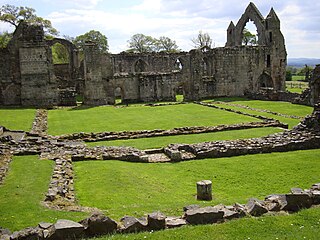
Haughmond Abbey is a ruined, medieval, Augustinian monastery a few miles from Shrewsbury, England. It was probably founded in the early 12th century and was closely associated with the FitzAlan family, who became Earls of Arundel, and some of their wealthier vassals and allies. It was a substantial, successful and wealthy house for most of its four centuries, although evidence of abuses appeared before its dissolution in 1539. The buildings fell into disrepair and the church was largely destroyed, although the remains of some of the domestic buildings remain impressive. The site is now in the care of English Heritage and is open to the public throughout the year and free entry.
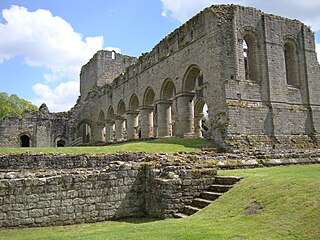
Buildwas Abbey was a Cistercian monastery located on the banks of the River Severn, at Buildwas in Shropshire, England - today about 2 miles (3.2 km) west of Ironbridge. Founded by the local bishop in 1135, it was sparsely endowed at the outset but enjoyed several periods of growth and increasing wealth: notably under Abbot Ranulf in the second half of the 12th century and again from the mid-13th century, when large numbers of acquisitions were made from the local landed gentry. Abbots were regularly used as agents by Plantagenet in their attempts to subdue Ireland and Wales and the abbey acquired a daughter house in each country.

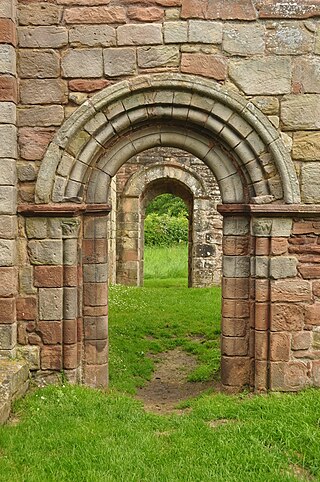
White Ladies Priory, once the Priory of St Leonard at Brewood, was an English priory of Augustinian canonesses, now in ruins, in Shropshire, in the parish of Boscobel, some eight miles (13 km) northwest of Wolverhampton, near Junction 3 of the M54 motorway. Dissolved in 1536, it became famous for its role in the escape of Charles II of England after the Battle of Worcester in 1651. The name 'White Ladies' refers to the canonesses who lived there and who wore white religious habits.
Robert of Shrewsbury was an English cleric, administrator, and judge of the Angevin period. His career culminated in his appointment as Bishop of Bangor.
Richard de Belmeis I was a medieval cleric, administrator, judge and politician. Beginning as a minor landowner and steward in Shropshire, he became Henry I's chief agent in the Welsh Marches and in 1108 was appointed Bishop of London. He founded St Osyth's Priory in Essex and was succeeded by a considerable dynasty of clerical politicians and landowners.
Richard de Belmeis was a medieval cleric, administrator and politician. His career culminated in election as Bishop of London in 1152. He was one of the founders of Lilleshall Abbey in Shropshire.
Alan fitz Flaad was a Breton knight, probably recruited as a mercenary by Henry I of England in his conflicts with his brothers. After Henry became King of England, Alan became an assiduous courtier and obtained large estates in Norfolk, Sussex, Shropshire, and elsewhere in the Midlands, including the feudal barony and castle of Oswestry in Shropshire. His duties included supervision of the Welsh border. He is now noted as the progenitor of the FitzAlan family, the Earls of Arundel (1267–1580), and the House of Stuart, although his family connections were long a matter of conjecture and controversy.

Lilleshall Abbey was an Augustinian abbey in Shropshire, England, today located 6 miles (9.7 km) north of Telford. It was founded between 1145 and 1148 and followed the austere customs and observance of the Abbey of Arrouaise in northern France. It suffered from chronic financial difficulties and narrowly escaped the Dissolution of the Lesser Monasteries in 1536, before going into voluntary dissolution in 1538.
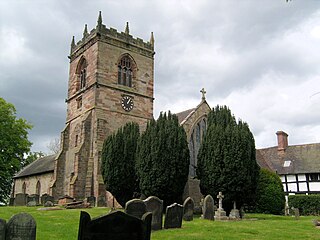
Lapley Priory was a priory in Staffordshire, England. Founded at the very end of the Anglo-Saxon period, it was an alien priory, a satellite house of the Benedictine Abbey of Saint-Remi or Saint-Rémy at Reims in Northern France. After great fluctuations in fortune, resulting from changing relations between the rulers of England and France, it was finally dissolved in 1415 and its assets transferred to the collegiate church at Tong, Shropshire.
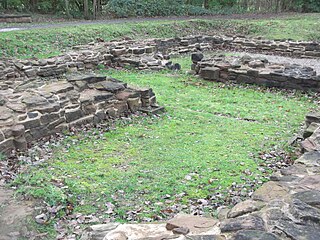
Sandwell Priory was a small medieval Benedictine monastery, near West Bromwich, then part of Staffordshire, England. It was founded in the late 12th century by a local landowner and was only modestly endowed. It had a fairly turbulent history and suffered considerably from mismanagement. It was dissolved in 1525 at the behest of Cardinal Wolsey – more than a decade before the main Dissolution of the Monasteries under Henry VIII.

St Mary Magdalene's Church is in the village of Battlefield, Shropshire, England, dedicated to Jesus' companion Mary Magdalene. It was built on the site of the 1403 Battle of Shrewsbury between Henry IV and Henry "Hotspur" Percy, and was originally intended as a chantry, a place of intercession and commemoration for those killed in the fighting. It is probably built over a mass burial pit. It was originally a collegiate church staffed by a small community of chaplains whose main duty was to perform a daily liturgy for the dead. Roger Ive, the local parish priest, is generally regarded as the founder, although the church received considerable support and endowment from Henry IV.
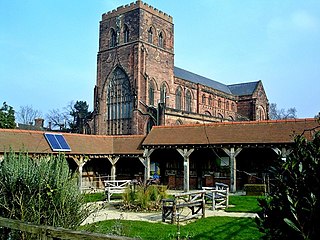
Thomas Prestbury was an English medieval Benedictine abbot and university Chancellor.
William FitzAlan (1085–1160) was a nobleman of Breton ancestry. He was a major landowner, a Marcher lord with large holdings in Shropshire, where he was the Lord of Oswestry, as well as in Norfolk and Sussex. He took the side of Empress Matilda during the Anarchy and underwent considerable hardship in the Angevin cause before regaining his lands and former status. William's younger brother, Walter fitz Alan, became ancestor of the royal House of Stuart.

The recorded abbots of Shrewsbury run from c 1087, four years after Shrewsbury Abbey's foundation, to 1540, its dissolution under Thomas Cromwell. The abbey was large and well-endowed and the abbots were often important political figures as well as ecclesiastical leaders. They varied greatly over the centuries in ethnic and social origins, intellectual attainments and holiness of life. The first two, Fulchred and Godfred, were imported from Normandy. The remainder seem to have been born in Britain and most, but not all, were elected, or at least selected, from the chapter of the abbey. As important territorial magnates, the abbots were always called to take part in the sessions of Parliament from its very beginnings as an institution in 1265. As important figures in the Western Catholic Church, abbots were permitted by the Pope to wear the pontifical ring from 1251 and the mitre from 1397.
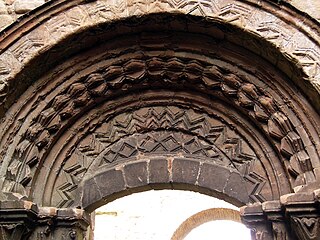
John Mirk was an Augustinian Canon Regular, active in the late 14th and early 15th centuries in Shropshire. He is noted as the author of widely copied, and later printed, books intended to aid parish priests and other clergy in their work. The most famous of these, his Book of Festivals or Festial was probably the most frequently printed English book before the Reformation.

Robert of Shrewsbury or Robertus Salopiensis was a Benedictine monk, prior and later abbot of Shrewsbury Abbey, and a noted hagiographer.

The Collegiate Church of St Bartholomew, Tong is a 15th-century church in the village of Tong, Shropshire, England, notable for its architecture and fittings, including its fan vaulting in a side chapel, rare in Shropshire, and its numerous tombs. It was built on the site of a former parish church and was constructed as a collegiate church and chantry on the initiative of Isabel Lingen, who acquired the advowson from Shrewsbury Abbey and additional endowments through royal support. Patronage remained with the lords of the manor of Tong, who resided at nearby Tong Castle, a short distance to the south-west, and the tombs and memorials mostly represent these families, particularly the Vernons of Haddon Hall, who held the lordship for more than a century. Later patrons, mostly of landed gentry origin, added further memorials, including the Stanley Monument which is inscribed with epitaphs said to be specially written by William Shakespeare.



















